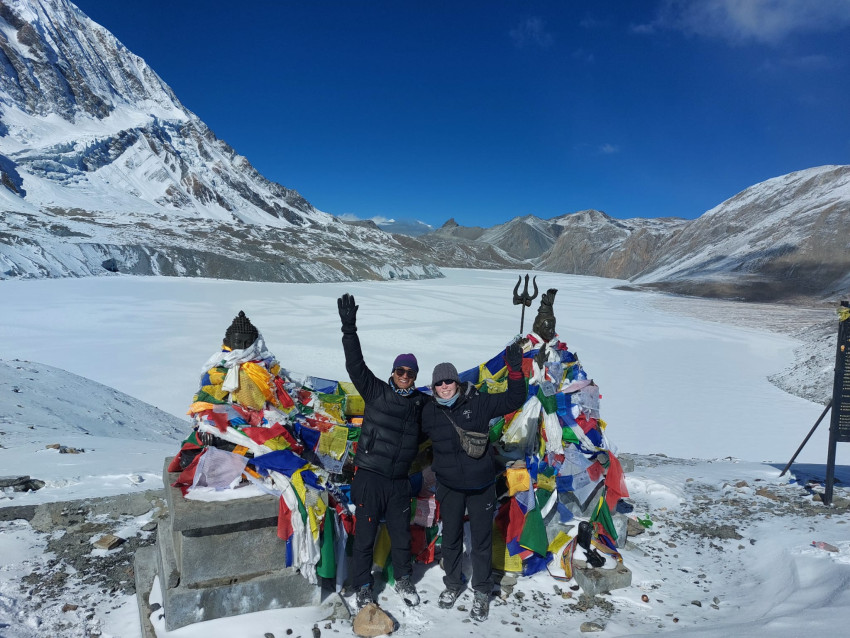
The short Annapurna Circuit trek is a condensed version of the classic Annapurna Circuit Trek, which is one of the most renowned Teahouse trekking routes in the world, located in the Annapurna region of Nepal. The traditional Annapurna Circuit trek usually takes around 18–21 days to complete and circumnavigates the Annapurna Massif, offering stunning views of snow-capped peaks, lush valleys, and diverse landscapes.
This trekking route in Annapurna typically covers the lower sections of the circuit, focusing on the most scenic and culturally rich parts of the route. It usually takes around 10–12 days to complete, starting from kathmandu and ending in the town of Besisahar or nearby Pokhara. This shorter version allows trekkers to experience the highlights of the Annapurna region within a more manageable timeframe, making it ideal for those with limited time or less experience in high-altitude trekking.
The short Annapurna Circuit trek route begins with a 7-hour drive from Kathmandu to Besisahar, followed by a 6-hour drive to Chame the next day. From Chame, the trekking journey unfolds through varied landscapes, encompassing terraced fields, flowing rivers, and towering peaks. Stops include Pisang, Manang, Tilicho Base Camp, Tilicho Lake, Sri Kharka, Ledar, and High Camp, each offering unique experiences of the Annapurna region’s rich culture and breathtaking natural beauty.
The trek culminates in a challenging ascent to Muktinath via Thorong La pass, followed by a descent to Jomsom and a scenic drive to Pokhara, completing the unforgettable adventure.
Highlights:
1. Spectacular Scenery: The short Annapurna Circuit trek promises awe-inspiring vistas at every turn. From the lush forests and terraced fields of the lower valleys to the stark, rugged beauty of the high-altitude landscapes, each scene is a masterpiece crafted by nature’s hand. Trekkers are treated to panoramic views of towering peaks, including Annapurna, Dhaulagiri, and Machhapuchhre, creating an unforgettable backdrop for their journey.
2. Cultural Immersion: Beyond its natural splendor, the Annapurna region is a melting pot of diverse cultures and traditions. Along the trail, travelers encounter charming villages inhabited by ethnic communities such as the Gurung, Magar, and Thakali people. Each village offers a glimpse into the unique way of life and hospitality of its residents, fostering meaningful cultural exchanges and memories that last a lifetime.
3. Thorong La Pass: One of the highlights of the short Annapurna Circuit trek is the opportunity to conquer Thorong La Pass, one of the highest mountain passes in the world. Standing at an elevation of 5,416 meters, the pass presents a formidable yet rewarding challenge for trekkers. The breathtaking views from the summit serve as a testament to the triumph of human spirit and the untamed beauty of the Himalayas.
4. Natural Splendor: Enveloped within the Annapurna Conservation Area, trekkers are immersed in a sanctuary of biodiversity and natural beauty. The conservation area is home to diverse flora and fauna, including rare species such as the snow leopard and Himalayan monal. With its pristine forests, alpine meadows, and tranquil lakes, the region offers a glimpse into the fragile yet resilient ecosystems of the Himalayas.
Itinerary:
The itinerary for the short Annapurna Circuit trek typically spans around 5–10 days, depending on the chosen route and pace of the trek. A common starting point is the village of Chamje or Besisahar, accessible by road from Kathmandu. From there, trekkers embark on a journey through a variety of landscapes, including lush forests, terraced fields, and high-altitude deserts.
The trek proceeds through picturesque villages such as Manang, where travelers can acclimatize to the altitude and explore the local culture and traditions. The highlight of the journey is crossing Thorong La Pass, a challenging yet exhilarating experience that offers unparalleled views of the surrounding mountains and valleys.
After descending from the pass, the trail leads to the town of Jomsom, known for its apple orchards and traditional Tibetan architecture. From Jomsom, trekkers have the option to continue their journey to the sacred pilgrimage site of Muktinath or conclude their trek and catch a flight back to Pokhara.
- Day 01: Drive from Kathmandu to Besisahar (760m) 7 Hrs Drive
- Day 02: Drive from Besisahar to Chame (1430m) 6 Hrs Drive
- Day 03: Trek from Chame to Pisang (3200m) 5–6 Hrs Trek
- Day 04: Trek Pisang to Manang (3540m) 3–4 Hrs Trek
- Day 05: Acclimatization in Manang (3540 m)
- Day 06: Trek from Manang to Tilicho Base Camp (4140m) 6–7 Hrs Trek
- Day 07: Trek to Tilicho Lake (4920 m) and return to base camp and trek to Sri Kharka (4060m) 6–7 Hrs Trek
- Day 08: Trek from Sri Kharka to Ledar (4373m) 3–4 Hrs Trek
- Day 09: Trek from Ledar to High Camp (4600m) 4–5 Hrs Trek
- Day 10: A hike from High Camp to Muktinath (3,800m) through Thorong La passes (5,416m) 7–8 Hrs Trek
- Day 11: Trek from Muktinath to Jomsom
- Day 12: Drive from Jomsom to Pokhara
Note :Itinerary from nmanepal.com
Preparation:
Before heading on the short Annapurna Circuit trek, it is essential to undertake thorough preparations to ensure a safe and enjoyable experience. Here are some key considerations:
1. Physical Fitness: The trek involves walking for several hours each day, often at high altitudes. Prior physical fitness training, including cardiovascular exercises and strength training, can help prepare the body for the rigors of the journey.
2. Packing Essentials: Packing the right gear and equipment is crucial for a successful trek. Essentials include sturdy hiking boots, warm clothing, waterproof outerwear, a comfortable backpack, and a sleeping bag suitable for cold temperatures. Additionally, it’s essential to carry ample water, snacks, sunscreen, and a first-aid kit.
3. Altitude Acclimatization: Adequate acclimatization is vital to prevent altitude sickness and ensure a safe ascent to high altitudes. Trekkers should plan their itinerary with built-in rest days to allow the body to adjust gradually to the reduced oxygen levels at higher elevations.
4. Local Guide and Permits: Hiring a local guide or joining a guided trekking group can enhance the overall experience and ensure navigation through unfamiliar terrain. Additionally, trekkers must obtain the necessary permits, including the Annapurna Conservation Area Permit (ACAP) and Trekkers’ Information Management System (TIMS) card, before starting the trek.
5. Respect for Nature and Culture: As stewards of the environment, trekkers should practice responsible tourism and minimize their impact on the fragile ecosystems of the Himalayas. Respecting local customs and traditions, including dress codes and photography etiquette, fosters positive interactions with the communities along the trail.
By following these guidelines and embracing the spirit of adventure and exploration, trekkers can embark on a transformative journey through the enchanting landscapes and vibrant cultures of the short Annapurna Circuit trek.
This expanded version provides a more in-depth exploration of the short Annapurna Circuit trek, offering insights into its highlights, itinerary, and essential preparations for prospective trekkers.







